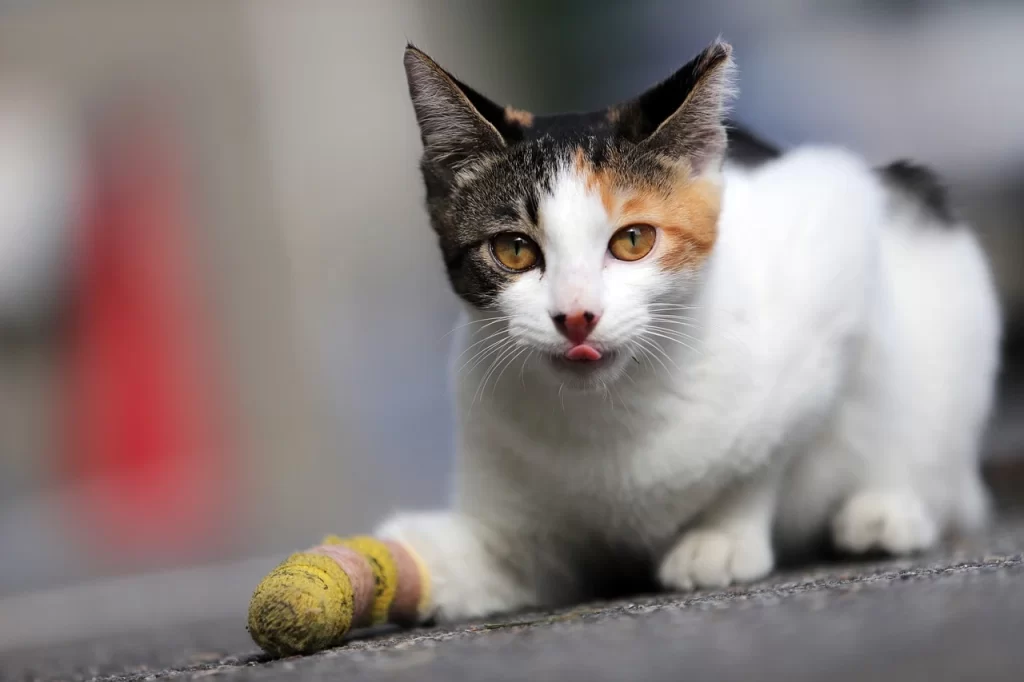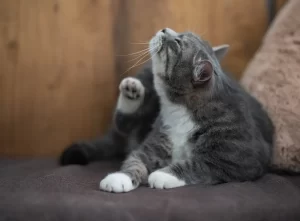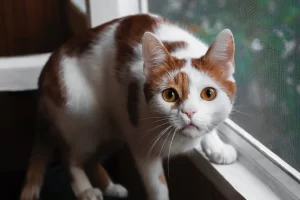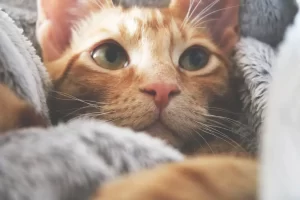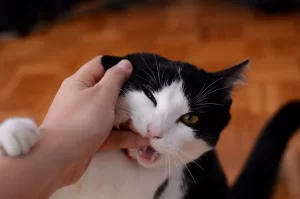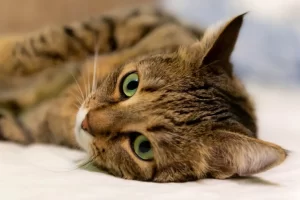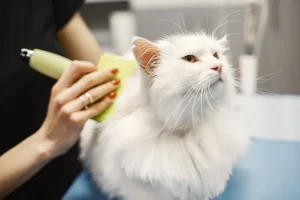Swollen legs in cats can be caused by a variety of factors, including injury, infection, and underlying health conditions. It’s important for cat owners to be able to recognize the signs and symptoms of a swollen leg and to take appropriate action to manage the condition. In this article, we’ll cover the most important topics you need to know about cat swollen leg home remedies, including the causes of swollen legs, signs and symptoms, home remedies and natural remedies to help manage swelling, preventing further injury and swelling, potential complications, monitoring your cat’s condition and the importance of a healthy diet and regular exercise in maintaining overall health and reducing the risk of swelling.
Table of Contents
ToggleCauses of swollen legs in cats
The main causes of swollen legs in cats are:
- Trauma or injury: A cat’s leg can become swollen as a result of an injury, such as a bite or a puncture wound.
- Arthritis: Swelling in a cat’s leg can be caused by arthritis, a degenerative joint disease that is common in older cats.
- Tumors: Tumors can also cause a cat’s leg to become swollen.
- Lymphoma: A type of cancer that affects the lymphatic system, lymphoma can cause swelling in a cat’s legs. Your cat may benefit from these homeopathic treatments if he or she is suffering from cancer.
- Infection: Bacterial or fungal infections can cause a cat’s leg to become swollen.
- Thromboembolism: This is a serious condition in which a blood clot forms in the leg and blocks the flow of blood, causing swelling.
- Allergies: Allergic reactions can cause swelling in a cat’s legs.
- Flea Allergy Dermatitis: an allergic reaction to flea bites can cause swollen leg in cats.
- Kidney disease: Chronic kidney disease can cause a cat’s legs to become swollen.
- Hyperthyroidism: An overactive thyroid can cause swelling in a cat’s legs. It is important to note that these are not the only possible causes and a proper diagnosis by a veterinarian is needed to determine the underlying cause of the swelling. Read more about this complication and its potential natural treatments here.
Signs and symptoms of a swollen leg in cats
Recognizing the signs and symptoms of a swollen leg in cats is crucial for providing the appropriate care and treatment. Some of the most common signs and symptoms of a swollen leg in cats include:
- Limping or favoring one leg over the others
- Swelling or puffiness in one or more legs
- Heat or warmth to the touch on the affected leg
- Redness or discoloration on the affected leg
- Tenderness or pain when the affected leg is touched
- Loss of appetite or decreased activity level
- Difficulty standing or walking
- Licking or biting at the affected leg
- Increased thirst and urination
Rapid breathing or panting. It’s important to note that these symptoms can be caused by other conditions as well, and a proper diagnosis by a veterinarian is needed to determine the underlying cause of the swelling and the symptoms.
Understanding the relationship between different causes of swollen legs in cats and the corresponding symptoms can help cat owners identify the underlying issue and seek appropriate treatment. The following are some examples of causes of swollen legs in cats and their corresponding symptoms:
- Trauma or injury: Limping, pain, swelling, redness, heat and tenderness to the touch are common symptoms of a swollen leg caused by trauma or injury.
- Arthritis: Lameness, pain, stiffness, decreased range of motion and difficulty walking are common symptoms of a swollen leg caused by arthritis.
- Tumors: Swelling, pain, lameness, and/or difficulty walking may be caused by tumors.
- Lymphoma: Swelling, pain, lameness, and/or difficulty walking may be caused by lymphoma.
- Infection: Swelling, redness, heat, pain, discharge, and fever may be caused by infection.
- Thromboembolism: Sudden onset of severe lameness, pain, and/or difficulty walking, along with a swollen limb, may be caused by thromboembolism.
- Allergies: Swelling, redness, itching, hives, and/or difficulty breathing may be caused by allergies.
- Flea Allergy Dermatitis: Swelling, redness, itching, and/or hair loss may be caused by flea allergy dermatitis
- Kidney disease: Swelling, fatigue, increased thirst, loss of appetite and weight loss, may be caused by kidney disease.
- Hyperthyroidism: weight loss, increased appetite, increased thirst and urination, restlessness, and vomiting, may be caused by Hyperthyroidism. It is important to note that these symptoms can also be caused by other conditions and a proper diagnosis by a veterinarian is needed to determine the underlying cause of the swelling and the symptoms.
Read More: How often do you take a cat to the vet?
Cat with swollen leg: Home remedies
Home remedies for managing swelling in cats can be broadly categorized into the following groups:
- Cold therapy: Using a cold compress or ice pack on the affected area can help reduce swelling and inflammation.
- Compression: Wrapping the affected leg with an elastic bandage can help reduce swelling by applying gentle pressure to the area.
- Elevation: Elevating the affected leg can help reduce swelling by promoting the flow of blood and fluids away from the area.
- Massage: Gently massaging the affected leg can help improve circulation and reduce swelling.
- Herbal remedies: Some herbal remedies, such as arnica, can help reduce swelling and promote healing.
- Diet and supplements: Certain supplements such as omega-3 fatty acids and antioxidants can help reduce inflammation and swelling.
It is important to note that these remedies are not substitute for professional medical treatment and it is important to consult a veterinarian before starting any home remedies.
Cold therapy
Cold therapy is a method of using cold temperatures to reduce swelling and inflammation in the affected area. The most common method of cold therapy for cats is by using a cold compress or ice pack.
To use a cold compress, wrap a few ice cubes in a towel or baggie, then apply it to the affected leg for 10-15 minutes at a time. Repeat this process several times a day as needed. You can also use a bag of frozen vegetables, such as peas or corn, as an ice pack.
The reason cold therapy is helpful is because the cold temperature constricts blood vessels, which reduces blood flow and the amount of fluid that can accumulate in the affected area. This helps to reduce swelling and inflammation, which can provide pain relief for the cat. Cold therapy can also help to numb the affected area, which can provide an additional layer of pain relief.
It’s important to note that cold therapy should be used with caution and never applied directly to the skin or for more than 20 minutes at a time to avoid cold injury. It’s also important to monitor the cat during the application of cold therapy and stop if they show any signs of discomfort or distress.
Compression
Compression is a method of using gentle pressure to reduce swelling in the affected area. The most common method of compression for cats is by using an elastic bandage.
To use an elastic bandage, wrap the affected leg starting from the foot and working your way up to the top of the leg. Make sure the bandage is not too tight and that the cat can still move and walk comfortably. Leave the bandage on for about an hour or two, and then remove it for about 15-20 minutes before reapplying. Repeat this process several times a day as needed.
The reason compression is helpful is that it helps to reduce blood flow and the amount of fluid that can accumulate in the affected area. This helps to reduce swelling and inflammation, which can provide pain relief for the cat. Compression can also help to support the affected leg, which can provide additional stability and help the cat to walk more comfortably.
It’s important to note that compression should be used with caution and never applied too tightly or for too long. It’s also important to monitor the cat during the application of compression and stop if they show any signs of discomfort or distress. Consultation with a veterinarian is crucial before starting any compression bandage treatment.
Elevation
The elevation is a method of using gravity to reduce swelling in the affected area. The most common method of elevation for cats is by using a pillow or other soft surface to raise the affected leg.
To use elevation, place a pillow or other soft surface under the affected leg. The leg should be elevated above the level of the cat’s heart. Leave the leg elevated for about 15-20 minutes at a time, and repeat this process several times a day as needed.
The reason elevation is helpful is because it promotes the flow of blood and fluids away from the affected area. This helps to reduce swelling and inflammation, which can provide pain relief for the cat. Elevation can also help to reduce the pressure on the affected leg, which can provide additional stability and help the cat to walk more comfortably.
It’s important to note that elevation should be used with caution and never applied for too long. It’s also important to monitor the cat during the application of elevation and stop if they show any signs of discomfort or distress. Consultation with a veterinarian is crucial before starting any elevation treatment. Also, it is important to make sure the cat is comfortable and safe while the leg is elevated.
Massage
Massage is a method of using gentle touch and pressure to reduce swelling in the affected area. The most common method of massage for cats is by using gentle strokes and circular motions along the affected leg.
To use massage, gently stroke the affected leg starting from the foot and working your way up to the top of the leg. Use circular motions to massage the affected area. Repeat this process several times a day as needed.
The reason massage is helpful is because it promotes the flow of blood and fluids in the affected area, which can help to reduce swelling and inflammation. It also helps to increase the range of motion in the affected joint and provide pain relief. Massage can also help to stimulate the release of endorphins, which are natural pain-relieving chemicals in the body.
It’s important to note that massage should be used with caution and never applied too firmly. It’s also important to monitor the cat during the massage and stop if they show any signs of discomfort or distress. Consultation with a veterinarian is crucial before starting any massage treatment. Also, it’s important to make sure the cat is comfortable and safe while receiving the massage.
Herbal remedies
Herbal remedies are a natural way to manage swelling and inflammation in cats. Some commonly used herbs for this purpose include:
- Turmeric – Can be given to cats in a powdered form or as a supplement. Known for its anti-inflammatory properties.
- Ginger – Can be given to cats in a powdered form or as a supplement. Known for its anti-inflammatory properties.
- Arnica – Can be applied topically as a cream or ointment. Known for its anti-inflammatory properties.
- Calendula – Can be applied topically as a cream or ointment. Known for its anti-inflammatory properties and wound healing abilities. See other natural antibiotics for cat wounds.
- Chamomile – Can be given as a tea or applied topically as a cream or ointment. Known for its anti-inflammatory properties and calming effects.
- Echinacea – Can be given as a supplement. Known for its immune-boosting properties and wound healing abilities.
- Meadowsweet – Can be given as a tea or supplement. Known for its anti-inflammatory properties and pain relief.
- Boswellia – Can be given as a supplement. Known for its anti-inflammatory properties and pain relief.
- Devil’s claw – Can be given as a supplement. Known for its anti-inflammatory properties and pain relief.
- Willow bark – Can be given as a supplement. Known for its anti-inflammatory properties and pain relief.
It’s important to note that some herbs may be toxic to cats if not used in the right amount or if the cat is already taking other medications. Consultation with a veterinarian is crucial before starting any herbal treatment. It’s also important to always follow the instructions for dosage and usage for each herb, as well as to monitor the cat for any adverse reactions.
Diet and supplements
Diet and supplements can also play a role in managing swelling in cats. Some options include:
- Omega-3 fatty acids – These can be found in fish oil supplements and can help to reduce inflammation in the body. It’s important to give the correct dosage as per the consultation with a veterinarian.
- Glucosamine and chondroitin – These supplements can help to support joint health and can be helpful in reducing inflammation and pain associated with joint problems.
- Vitamin C – This antioxidant can help to reduce inflammation and support the immune system. It can be given as a supplement or can be included in the diet by feeding fruits and vegetables high in vitamin C.
- Vitamin E – This antioxidant can help to reduce inflammation and support the immune system. It can be given as a supplement or can be included in the diet by feeding fruits and vegetables high in vitamin E.
- Green-lipped mussel – This natural supplement is rich in Omega-3 fatty acids and can help to reduce inflammation and support joint health.
It’s important to note that supplements should be used with caution and only given under the guidance of a veterinarian. And also, it’s important to monitor the cat for any adverse reactions and adjust the dosage as necessary.
A diet high in anti-inflammatory foods can also be beneficial for managing swelling. Some examples include fish, fruits and vegetables, nuts and seeds, and whole grains. Consultation with a veterinarian is crucial before making any changes to the cat’s diet.
Preventing Infection in swollen cat legs
Preventing infection in swollen cat legs requires diligent care and hygiene. To protect the affected area and support the healing process, consider the following steps:
- Gently clean the area with mild soap and water or a gentle antiseptic solution.
- If necessary, apply a clean bandage or dressing to shield the wound.
- Whenever possible, keep the affected leg elevated to reduce swelling.
- Be cautious to prevent activities or movements that could worsen the injury or cause additional harm to the area.
- Change the bandage or dressing regularly to maintain cleanliness and dryness.
- Maintain vigilance for signs of infection, such as redness, warmth, or discharge, and promptly consult with a veterinarian if any of these symptoms appear.
It’s essential to recognize that any injury or wound carries the risk of infection and should be handled with meticulous cleanliness to prevent further complications. If the cat is prone to licking the affected area, consider using a cone collar as a preventive measure.
Preventing swelling in cats
Preventing injury and swelling can help to keep your cat healthy and comfortable. Here are some tips for preventing injury and swelling in cats:
- Provide a safe and comfortable environment for your cat. This includes keeping the living space free from hazards, such as toxic chemicals or sharp objects, and making sure there are plenty of comfortable and cozy places for your cat to rest and sleep.
- Keep your cat at a healthy weight. Obesity can put extra stress on joints and increase the risk of injury.
- Provide plenty of exercise and playtime for your cat. Regular exercise can help to keep your cat’s muscles and joints strong and flexible.
- Keep your cat’s nails trimmed. Long nails can cause injury and pain when your cat walks or runs.
- Keep an eye on your cat’s mobility. If you notice any signs of limping or difficulty moving, consult with a veterinarian right away.
- Regular check-ups with a veterinarian. Regular check-ups can help to catch any potential health problems early, before they become major issues.
- Provide a proper diet and nutrition. A well-balanced diet can help to keep your cat healthy and strong.
- Keep your cat’s living space clean and free from debris. This can reduce the risk of injury caused by tripping or falling.
- Provide plenty of scratching post and toys for your cat to play with. This can help to prevent boredom and reduce the risk of injury caused by rough play.
- Be aware of your cat’s behavior and pay attention to any changes in its habits or routines. This can help you to identify any potential issues early on.
By taking the necessary precautions and providing the right care, you can help to keep your cat safe and healthy and reduce the risk of injury and swelling.
Complications of untreated swollen legs in cats
Untreated swollen legs in cats can lead to a number of complications, such as infection or permanent damage. Some potential complications of untreated swollen legs include:
- Infection: Swelling can be caused by infection and not treating it can lead to the spread of the infection to other areas of the body and can cause sepsis.
- Permanent damage: If the swelling is caused by an injury or disease, the affected limb may suffer permanent damage if left untreated. This can lead to chronic pain, arthritis, or even amputation.
- Loss of function: Swelling can cause the affected limb to lose function, making it difficult for your cat to move around or perform daily activities.
- Chronic pain: If the swelling is caused by an injury or disease, the affected limb may be in chronic pain if left untreated.
- Arthritis: Swelling can cause arthritis, which is a chronic and painful condition that affects the joints.
- Amputation: In some cases, swelling can lead to amputation if it causes permanent damage to the limb.
- Reduced quality of life: If your cat’s swollen leg causes chronic pain, loss of function, or any other health problems, it can greatly reduce their quality of life.
- Financial burden: Treating and caring for a cat with a swollen leg can be financially burdensome, especially if the condition requires surgery or long-term treatment.
It’s important to seek medical attention as soon as possible if your cat’s leg is swollen. Early diagnosis and treatment can help prevent these potential complications and improve the outcome for your cat.

